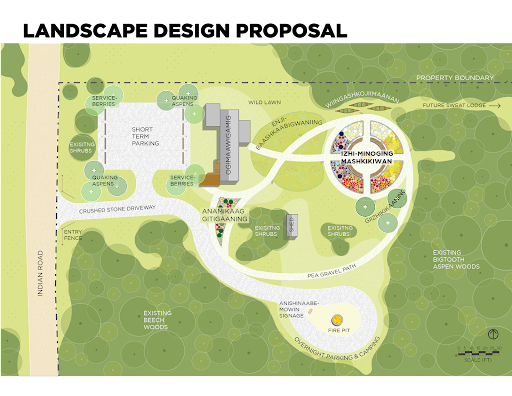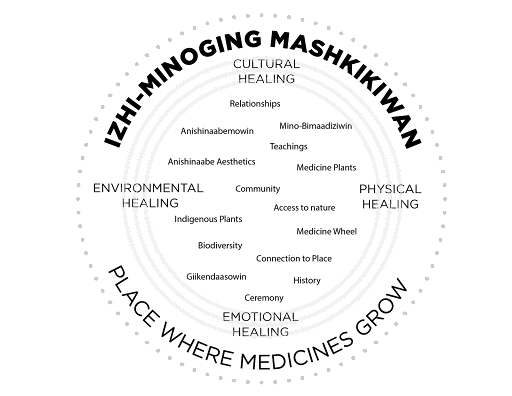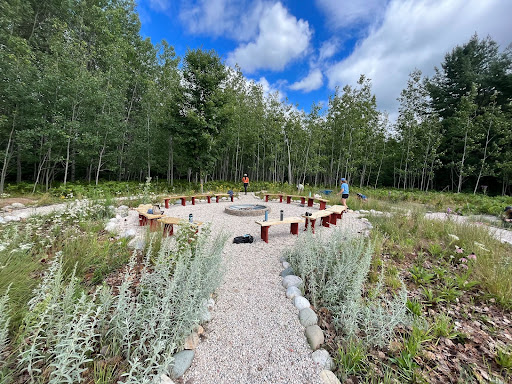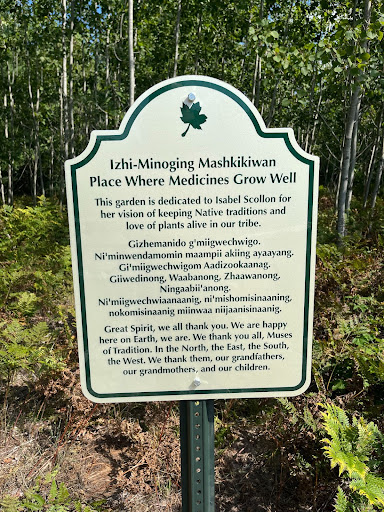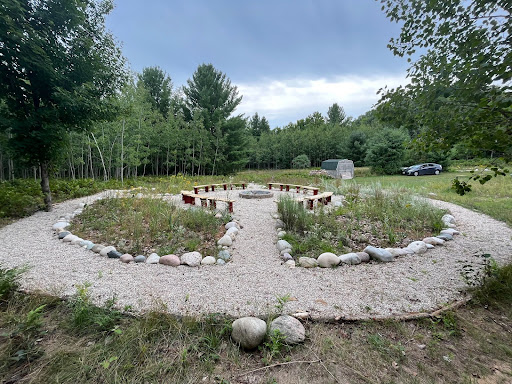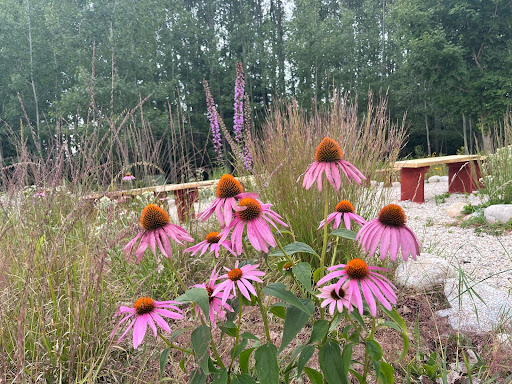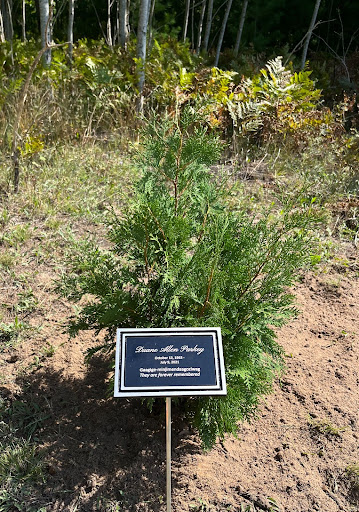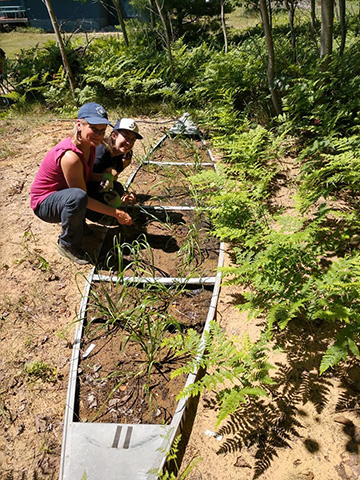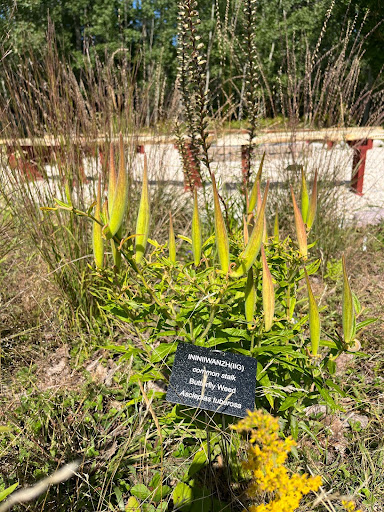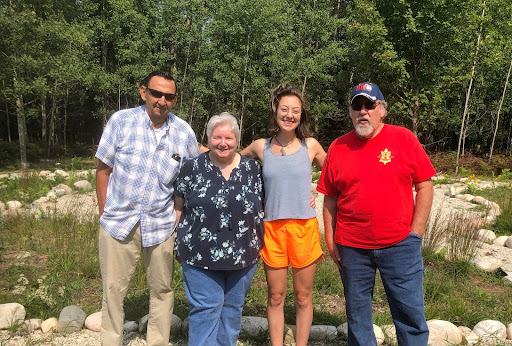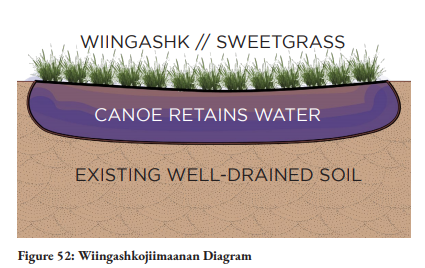Cheboiganing Burt Lake Band’s Healing Landscape & Garden
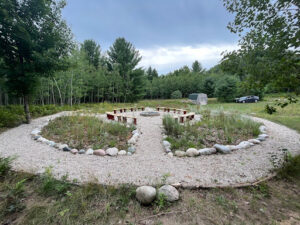
The Cheboiganing Burt Lake Band of Ottawa and Chippewa Indians, Inc
Izhi-Minoging Mashkikiwan – Place Where Medicines Grow Well
A healing garden and landscape for their headquarters
Izhi-Minoging Mashkikiwan, translated in English to “Place Where Medicines Grow Well”, is a healing garden stewarded by the Cheboiganing Burt Lake Band of Ottawa and Chippewa Indians, located at their headquarters in Brutus, MI. This garden is the main feature of a landscape design proposal created in on-going collaboration with the Burt Lake Band and landscape designer, Eva Roos, through her graduate work at University of Michigan. The healing garden tells the story of traditional Anishinaabeg principles and teachings encoded in the Ojibwe Medicine Wheel and symbolized through plant choices and placement. The garden features over 40 different perennial plant species, all native to the Great Lakes. The planting design is inspired by traditional Ojibwe floral beadwork, with each plant considered as a bead in a beading pattern. Learn more about the history of the Cheboiganing Band, and the historic events that inspired the idea of a healing garden. You can also see the Band featured at the University of Michigan Museum of Art in an exhibit, Future Cache, by Andrea Carlson.
This page contains a word list for every plant who lives in Izhi-Minoging Mashkikiwan. Four names are given – their Anishinaabemowin name, its direct translation to English, the common English name, and its Latin genus and species. Metal name plaques accompany plants within the garden for those who visit.
Thoughtful design ensures low maintenance, four-seasons of visual and sensory interest, and creates a space to support physical, mental, and cultural healing. Studying relationships between plant species determined how to create the plant communities associated with each direction on the Medicine Wheel. Four handmade cedar benches look towards a fire pit in the garden’s center. Izhi-Minoging Mashkikiwan is a gathering place for the community, for learning, to host traditional ceremonies, and to collectively remember experiences — all encircled by a protective and vibrant family of Great Lakes native plants.
The Burt Lake Band and Eva Roos worked together in the summer of 2021 to begin installation of the garden. Through multiple community planting days and gifts of plants, labor, artistry, time, and love, the garden came to life. The Burt Lake Band headquarters now also features additional elements of the original landscape design proposal:
The Cheboiganing Burt Lake Band and Eva Roos continue to update and care for the garden! In summer of 2023, Ojibwe artist, Andrea Carlson, will work with the Band on interpretive signage in Anishinaabemowin to guide visitors through the garden. In the meanwhile, the plants are growing beautifully with amazing vigor. The garden is ever-changing as the plants teach us about their preferences, needs, and nuances of their community. It’s wonderful to watch them grow, and we’re so grateful for how they heal us already. It’s clear they’re happy to be home.
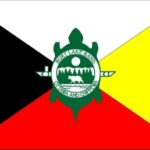 Note: The Healing Garden is not currently open to the public as it is a healing space specifically for the Burt Lake Band. Please engage with it online. You may contact the Band’s executive director, Nola Parkey, if you would like special permission to visit. The Band would appreciate any support in continuing to build their garden.
Note: The Healing Garden is not currently open to the public as it is a healing space specifically for the Burt Lake Band. Please engage with it online. You may contact the Band’s executive director, Nola Parkey, if you would like special permission to visit. The Band would appreciate any support in continuing to build their garden.
If you would like to visit the site of the actual burnout you can visit the Chaboiganing Nature Preserve. You could also connect with the Burt Lake Band’s Facebook page to learn when their annual Memorial Walk takes place.
Donate to the Burt Lake Band Garden
Design a Relationship Garden
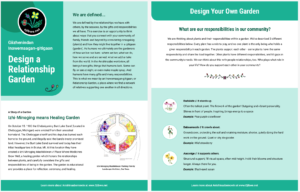
This garden includes plants that support one another. If you want to learn more about those relationships and how it might reflect your own life connections and relationships, download our Relationship Garden Worksheet.
Izhi-Minoging Mashkikiwan (Plants Names)
Gichimiigwechiwigo Michael Zimmerman Jr. gii-naadamawiyangid. We thank him for his help as we worked to find the most common or most logical name for every plant. Please note that some of these names are not currently used often but all of them are based on the use or characteristics of the plant. We welcome any feedback you may have or information about alternate names used by speakers of Anishinaabemowin in your community.
| WAABANONG (The East) | |||
|---|---|---|---|
| English | Scientific | Ojibwe | Literal Transation |
| Common Cinquefoil | Potentilla simplex | gichi-ode’iminijiibik(ag) | big heart seed root |
| Lance-leaf Coreopsis | Coreopsis lanceolata | ozaawaabigwan(iin) | yellow leaves |
| Prairie Ragwort | Packera plattensis | minokamibigwan(iin) | late spring bloom |
| Stiff Goldenwort | Solidago rigida | giizisomashkiki(wan) | sun medicine |
| Grey-Headed Coneflower | Ratibida pinnata | giizisobagoons(an) | sun leaves (little) |
| Black-Eyed Susan | Rudbeckia hirta | ozaawaa-bashkiibigwaniins(an) | yellow blossom |
| Yellow Prairie Grass | Sorghastrum nutans | zhiingidibe-miishkoons(an) | spread-headed grass |
| Prairie-Dock | Silphium terebinthinaceum | ginoozhewashk(oon) | long/tall stem |
| Showy Goldenrod | Solidago speciosa | ozaawaanagak(wag) | yellow leaves |
| Shrubby St. John’s Wort | Hypericum prolificum | wiisagibag(oon) | pain/hurt leaf |
| GIIWEDINONG (The North) | |||
|---|---|---|---|
| English | Scientific | Ojibwe | Literal Translation |
| Pussytoes | Antennaria plantaginifolia | gaagigebagoons(an) | forever leaf |
| Canada Anemone | Anemone canadensis | midewijiibik(ag) | oily root |
| Heath Aster | Symphyotrichum ericoides | waabigwaaniins(an) | little white bloomer |
| Common Yarrow | Achillea millefolium | ajidamoowaanow(ag) | squirrel tail |
| Rattlesnake Master | Eryngium yuccifolium | mizaanens(ag) | little fuzzy one |
| Flowering Spurge | Euphorbia corrolata | zhaabozigan(an) | something used as a laxative |
| Pearly Everlasting | Anaphalis margaritacea | bakwenezigan(an) | something used for smudging |
| Culver’s Root | Veronicastrum virginicum | wiisagijiibik(ag) | a root that is bitter |
| Prairie Dropseed | Sporobolus heterolepis | nabagashkoons(an) | little flattened plant |
| White Wild Indigo | Baptisia alba | dekaako-ino-giizhigak(in) | coolness of the day |
| Silverweed | Potentilla anserina | ode’iminigaawanzh(iig) | sharp-leaved like strawberries |
| ZHAAWANONG (The South) | |||
|---|---|---|---|
| English | Scientific | Ojibwe | Literal Translation |
| Wild Strawberry | Fragaria virginiana | ode’imin(an) | heart berry |
| Prairie Smoke | Geum triflorum | zhingidib(an) | spreading head |
| Marsh Blazing Star | Liatris spicata | mooz-waanow(ag) | moose tail |
| Royal Catchfly | Silene regia | miskwaabagak(in) | red petaled |
| Purple Coneflower | Echinacea purpurea | giizisobagoons(an) | little petals of the sun |
| Side-Oats Grama | Bouteloua curtipendula | agooji-anoomin(ag) | hanging oats |
| Purple Poppy Mallow | Callirhoe involucrata | miininiisabagoons(an) | little berry colored low leaf |
| Butterfly Weed | Asclepias tuberosa | ininiiwanzh(iig) | common stalk |
| Little Bluestem | Schizachyrium scoparium | mashkosiw(an) | hairy/furry |
| Spotted Horsemint | Monarda punctata | aamoogaawanzh(iig) | rising sharp branches |
| Purple Love Grass | Eragrostis spectabilis | miishimashkosiw(an) | fuzzy blade of grass |
| NIINGAABII’ANONG (The West) | |||
|---|---|---|---|
| English | Scientific | Ojibwe | Literal Translation |
| Prairie Onion | Allium stellatum | zhigaagawanzh(iig) | big spine plant |
| Bird’s Foot Violet | Viola pedata | ozhaawaashkwaabigwan(iin) | blue bloomers |
| Downy Wood Mint | Blephilia cilliata | aamoogaawanzh(iig) | rising sharp branches |
| Wild Lupine | Lupinus perenis | ozhaawaashkwaabakaanibigwan(iin) | blue differentiated bloomers |
| Pale Purple Coneflower | Echinacea pallida | waabigiizisobagoons(an) | white little petals of the sun |
| Smooth Blue Aster | Symphiotrichum laeve | mayaawadikwayaapin(iig) | central twig tuber |
| Prairie Sage | Artemisia ludoviciana | mashkodewashk(oon) | prairie plant |
| Lead Plant | Amorpha canescens | wayaabanaagwak(in) | appears light/pale |
| Wild Quinine | Parthenium integrifolium | banagiziganibigwan(iin) | bloomer that looks like hominy |
| Little Bluestem | Schizachyrium scoparium | mashkosiw(an) | hairy/furry |
| Black Chokeberry | Aronia melanocarpa | apwaajimin(an) | dehydrated/dried berry |

